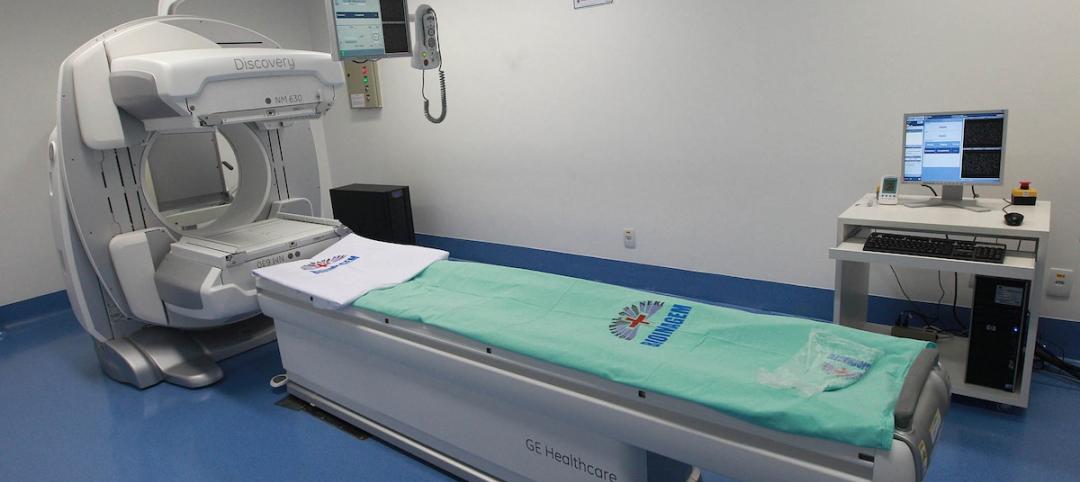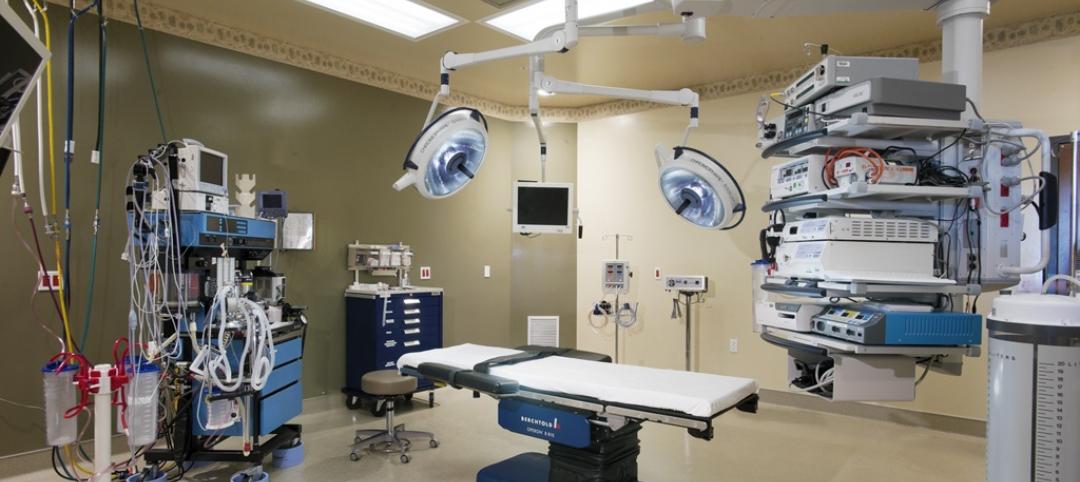This spring, the 1-million-sf Sidra Medicine in Doha, Qatar, is scheduled to launch a purpose-built clinic with in vitro fertilization services for reproductive consultation.
The hospital, which had its official opening on November 12, is one of the few in Qatar offering health services specifically for women and children. The facility, whose nearly $8 billion construction cost was endowed by Qatar Foundation, has more than 50 outpatient clinics and 400 inpatient beds, expandable to 550.
The hospital’s exterior design, by New Haven, Conn.-based Pelli Clarke Pelli Architects, is distinguished by three sails that take their cue from traditional boats known as dhows, and from sand patterns in Doha “that are quite beautiful,” says Mark Shoemaker, a Principal with Pelli Clarke Pelli. “These fluid forms inspired us.”

The hospital has three massive atriums, bathed in natural light. Image; Jeff Goldberg_Esto
The sails, clad in white ceramic tile, are part of massive atriums within the building, one of which includes a garden respite. The hospital also has a mosque, an ambulatory care center, and underground parking for 1,000 cars.
The medical center is positioned as a gateway to Education City, Doha’s 1.4-square-kilometer concentration of academic, science, and sports facilities. A tunnel connects the hospital directly to Cornell Weill Medical School, one of six campuses at Education City. (Other campuses are for Texas A&M, Carnegie Mellon University, and Virginia Commonwealth.)
The construction of Education City, which debuted in 1997, and Sidra Medicine was spearheaded by Sheikha Moza bint Nasser, chairperson of Qatar Foundation and consort to Sheikh Hamad bin Khalifa Al Thani, Qatar’s former Emir. Her Highness has been instrumental in advancing education and social reform in her country.
Shoemaker says Pelli Clarke Pelli was brought into the project by AECOM. (He once worked for Ellerbe Beckett, which designed the first Mayo Clinic. That firm is now part of AECOM). The team unveiled its design for Sidra Medical in 2007, and construction began in 2010.
Completion of the hospital was originally slated for 2011, and then 2015. The delays, explains Shoemaker, were partly attributable to the building’s size and complexity, but also to Building Team-related changes.
The hospital employs more than 4,000 people with 85 nationalities. Image: Sidra Medical and Research Center.
At one point AECOM left the project that then switched to a design-build delivery method led by Spain-based general contractor OHL, which had been in a joint venture with Contrack International for this project since 2008. Qatar Foundation fired OHL over delays in 2014, and OHL subsequently sued the foundation. Eventually, AECOM came back into the picture.
Sidra Medicine actually has been receiving patients since January 2018, and has staggered the opening of different departments—like robotic surgery last July. Shoemaker suggests this could be because Qatar doesn’t have enough trained medical professionals to meet the needs of such a large facility, and Sidra Medical has had to fill those gaps by recruiting (with Cornell Weill’s assistance) medical personnel from outside the country, mostly the United States and Europe.
When asked what his firm took away from this project, Shoemaker says that “it gave us the opportunity to experiment with different healthcare models for rooms and lobbies.” He adds that the design also paid attention to reflect Qatar’s culture.
Related Stories
Healthcare Facilities | Apr 8, 2015
Designing for behavioral health: Balancing privacy and safety
Gensler's Jamie Huffcut discusses mental health in the U.S. and how design can affect behavioral health.
Building Team Awards | Apr 5, 2015
‘Project first’ philosophy shows team’s commitment to a true IPD on the San Carlos Center
Skanska and NBBJ join forces with Sutter Health on a medical center project where all three parties share the risk.
Healthcare Facilities | Mar 31, 2015
BIM and the changing procurement model for medical equipment in healthcare construction
BIM coordination has dramatically reduced change orders during the construction period. Unfortunately, it has had the opposite effect on medical technology integration, writes CBRE Healthcare's Julie Ford.
Healthcare Facilities | Mar 28, 2015
VA construction program ‘a disaster,’ says congressman
The VA construction program took more hits recently after the chairman of a congressional Committee on Veterans’ Affairs called an Aurora, Colo., hospital project “a disaster,” and a key VA official resigned abruptly.
Healthcare Facilities | Mar 23, 2015
Can advanced elevator technology take vertical hospitals to the next level?
VOA's Douglas King recalls the Odyssey project and ponders vertical transportation in high-rise healthcare design.
Healthcare Facilities | Mar 22, 2015
New Joplin, Mo., hospital built to tornado-resistant standards
The new hospital features a window and frame system that can protect patients from winds of up to 250 mph.
Healthcare Facilities | Mar 19, 2015
Grumman/Butkus Associates releases 2014 hospital energy and water benchmarking survey results
The survey results show that hospitals’ overall fossil fuel use has trended downward, but electricity use isn’t declining much.
Healthcare Facilities | Mar 18, 2015
Healthcare design partnership asks: What about the doctor?
HDR's Abbie Clary discusses the design of healthcare facilities and how they affect doctors.
Healthcare Facilities | Mar 16, 2015
Healthcare planning in a post-ACA world: 3 strategies for success
Healthcare providers are seeking direction on how to plan for a value-based world while still very much operating in a volume-based market. CBRE Healthcare's Curtis Skolnick offers helpful strategies.
Retail Centers | Mar 10, 2015
Retrofit projects give dying malls new purpose
Approximately one-third of the country’s 1,200 enclosed malls are dead or dying. The good news is that a sizable portion of that building stock is being repurposed.

















